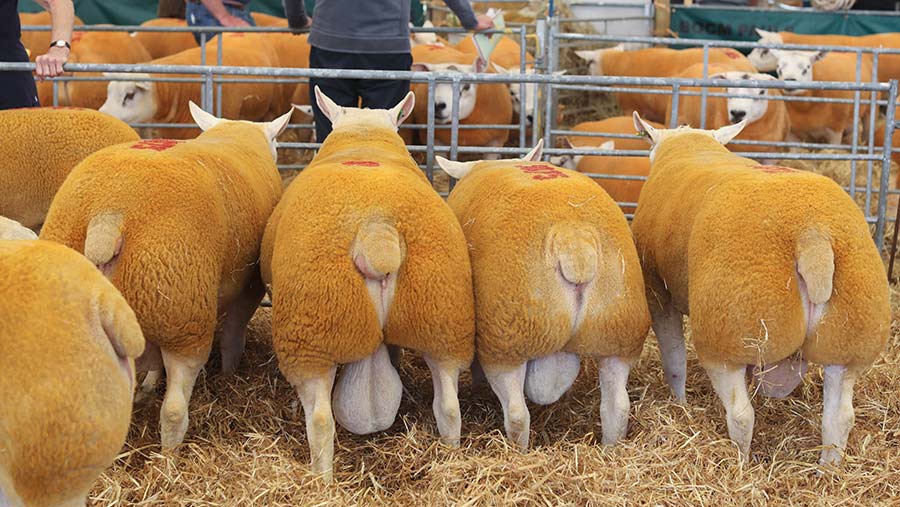5 tips on lifting flock fertility this autumn
 Rams should be quarantined and examined thoroughly before breeding after purchase © Tim Scrivener
Rams should be quarantined and examined thoroughly before breeding after purchase © Tim Scrivener Ewe fertility is one of the principal drivers of flock profitability, as the number of lambs scanned and born dictates output.
Factors ranging from condition score at mating to parasite burdens and disease can influence how ewes and rams will perform at tupping.
Below, vets Cath Tudor and Abbie Dimelow, of Prostock Vets, give advice on how breeders can lift flock fertility this autumn.
“Conducting health checks in the run-up to tupping will ensure that ewes and rams enter the breeding period in peak condition,” advises Ms Tudor.
See also: 5 tips from NZ to increase sheep flock returns by 30%
1. Keep bodyweight in check
The level of body reserves influences the hormones needed for breeding, which is why healthy bodyweight is crucial for fertility.
Being too fat or thin can reduce conception rates and it is not a quick fix to rectify – it takes eight weeks on unlimited grazing for a ewe to gain a single condition score.
Body condition score targets:
- Aim for body condition score (BCS) 5 in lowland breeds, 3 in upland flocks and 2.5 in hill ewes
- Rams are likely to lose two condition scores during tupping, so aim for BCS 3.5
2. Parasite controls
Ewes with high parasite burdens will have poorer fertility, but routine drenching pre-tupping isn’t necessary unless animals look thin or in poor condition.
Carry out faecal egg counting (FEC) to establish whether treatment is needed.
“A flock can be challenged by different worms from one year to the next, especially if there is incoming stock,’’ warns Ms Tudor.
Haemonchus is a tropical/sub-tropical worm that is increasingly prevalent in the UK as the climate warms.
Drench incoming stock as different flocks will have different anthelmintic resistance and there is no guarantee that they have been treated.
For advice on what to use visit the Scops website (PDF).
If your farm has wet land, a flukicide will need to be administered to ewes and rams, but blood and FEC tests in conjunction with your vet will inform this.
3. Vaccination
Nearly a quarter of all lamb losses on UK farms are due to abortion, yet enzootic abortion of ewes (EAE) and toxoplasma can be effectively controlled with vaccination.
Farmers recording flock barren rates of more than 2% should ask their vet to investigate whether a potential infectious cause of abortion is the root cause.
“Keep records. More than two abortions in every 100 sheep is not normal,” says Ms Dimelow.
Vaccination is key to preventing abortions from EAE and toxoplasmosis.
Protection against EAE from a vaccine administered at least four weeks prior to tupping lasts for three years, so for many flocks it is a “once in a lifetime” cost, while immunity in ewes vaccinated for toxoplasmosis before mating lasts for around 18 months.
“It is an investment worth making because the heartache and hassle at lambing is not what you need at your busiest time of the year,” adds Ms Dimelow.
4. Quarantine incoming rams and replacements
The quarantine period should ideally be 28 days.
“It is a bugbear of vets that ram sales are held so late in the year. Buying and selling should be in August to allow incoming stock a chance to settle down,” explains Ms Tudor.
Scab is prevalent in many regions and even an animal that is showing no symptoms might have picked it up at a sale – the parasite that causes it can live on surfaces such as gateposts for 17 days.
Blood test and if the result is positive dip before tupping if needed, as treatment during or after tupping will compromise fertility.
5. Assess rams
One in five rams is sub-fertile or infertile, with heat stress a factor – this decreases both the production and quality of semen and is likely to be an issue in many flocks this autumn.
If a ram gets a high temperature this can affect semen for up to eight weeks, so if a ram is lame or coughing, treat promptly.
“Check the physical wellbeing of rams before mating,’’ advises Ms Dimelow.
Consider teeth, toes, testicles and BCS, and get a full fertility check done 10 weeks before tupping.
“If a ram requires treatment or needs to gain condition, 10 weeks allows time to do something about it,” explains Ms Tudor. “If it is infertile there is still time to buy another ram,” she adds.
Shearling rams should have two broad incisors that meet the hard pad at right angles, not sloping forward. Cheek teeth can be felt from outside the jaw and should be regular.
See also: How to perform a dental examination on sheep
Feet should be sound with no inter-digital growths.
Check there are two testicles that move freely in the scrotum and feel firm but not solid, are free from any hard lumps and have an epididymis the size of a table tennis ball at the base.
Re-check everything two weeks before tupping.
Using a teaser can advance breeding by up to two weeks and enable compact lambing, but if you are intending to use one, keep the breeding rams out of sight, sound, and smell of the ewes for four to six weeks before tupping – at least a mile away.
One teaser ram is sufficient for 100 ewes.
For breeding rams, aim for one ram to 40 ewes in a hill flock and one for every 30 lowland ewes.
Cath Tudor and Abbie Dimelow were speaking in a recent Farming Connect webinar
